Systems Thinking for Sustainability: An Individual Research Paper
VerifiedAdded on 2022/09/18
|11
|3300
|13
Report
AI Summary
This research paper from La Trobe University's BUS2SBY course examines the critical role of systems thinking in addressing sustainability challenges, particularly focusing on gender bias and artificial intelligence. The paper contrasts systems thinking with traditional approaches, highlighting the interrelationships between various components within a system. It delves into the significance of systems thinking in solving complex sustainability issues, emphasizing the impact of AI and biased data on gender equality. The report discusses the evolution of AI, its potential to perpetuate biases, and strategies for mitigating these biases through stress-testing and improved algorithms. The conclusion underscores the importance of systems thinking in developing sustainable solutions and the need for increased awareness and research to combat gender bias in the age of AI. It also considers the long-term advantages of AI in fostering gender equality and reducing risks in various sectors.
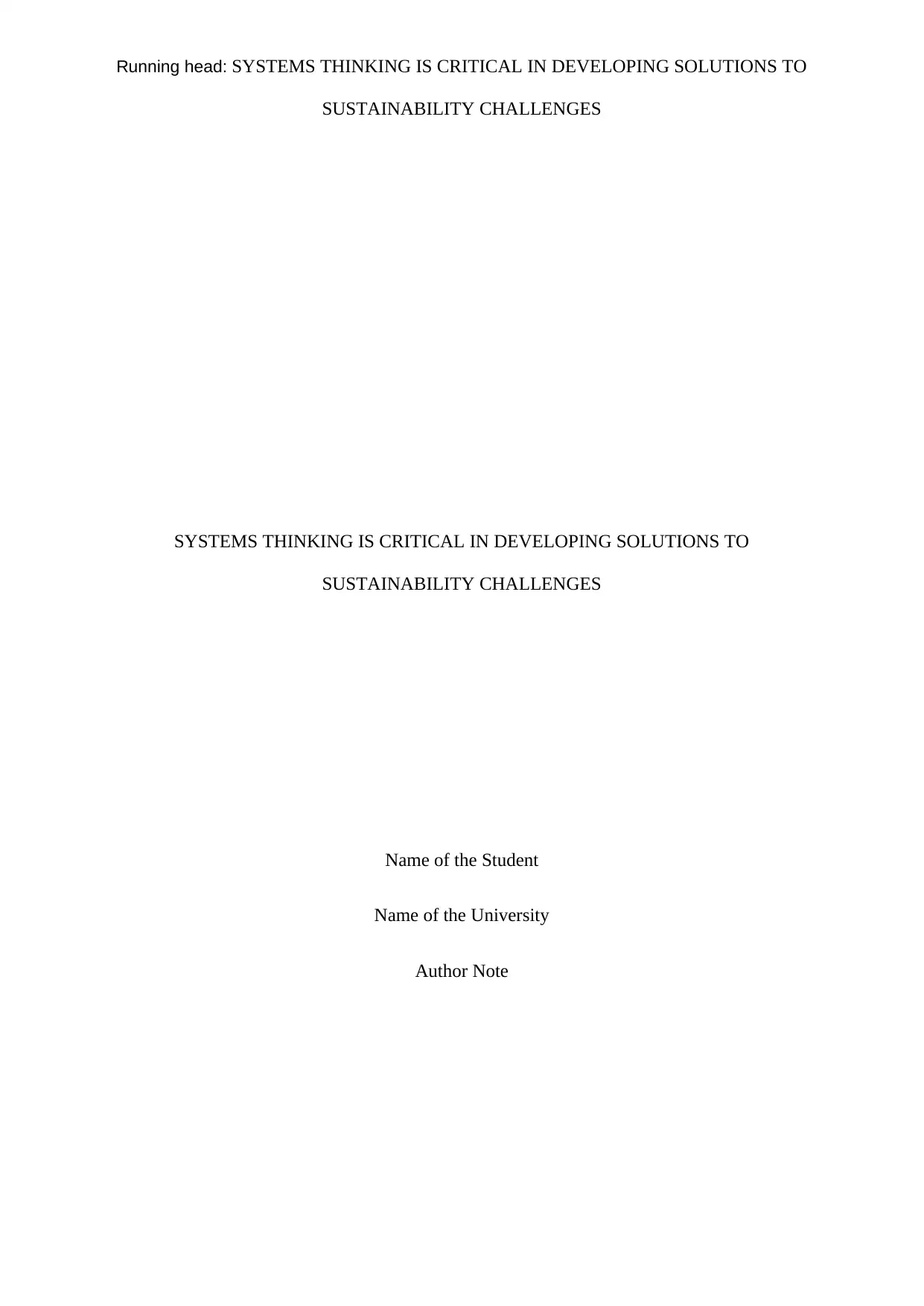
Running head: SYSTEMS THINKING IS CRITICAL IN DEVELOPING SOLUTIONS TO
SUSTAINABILITY CHALLENGES
SYSTEMS THINKING IS CRITICAL IN DEVELOPING SOLUTIONS TO
SUSTAINABILITY CHALLENGES
Name of the Student
Name of the University
Author Note
SUSTAINABILITY CHALLENGES
SYSTEMS THINKING IS CRITICAL IN DEVELOPING SOLUTIONS TO
SUSTAINABILITY CHALLENGES
Name of the Student
Name of the University
Author Note
Paraphrase This Document
Need a fresh take? Get an instant paraphrase of this document with our AI Paraphraser
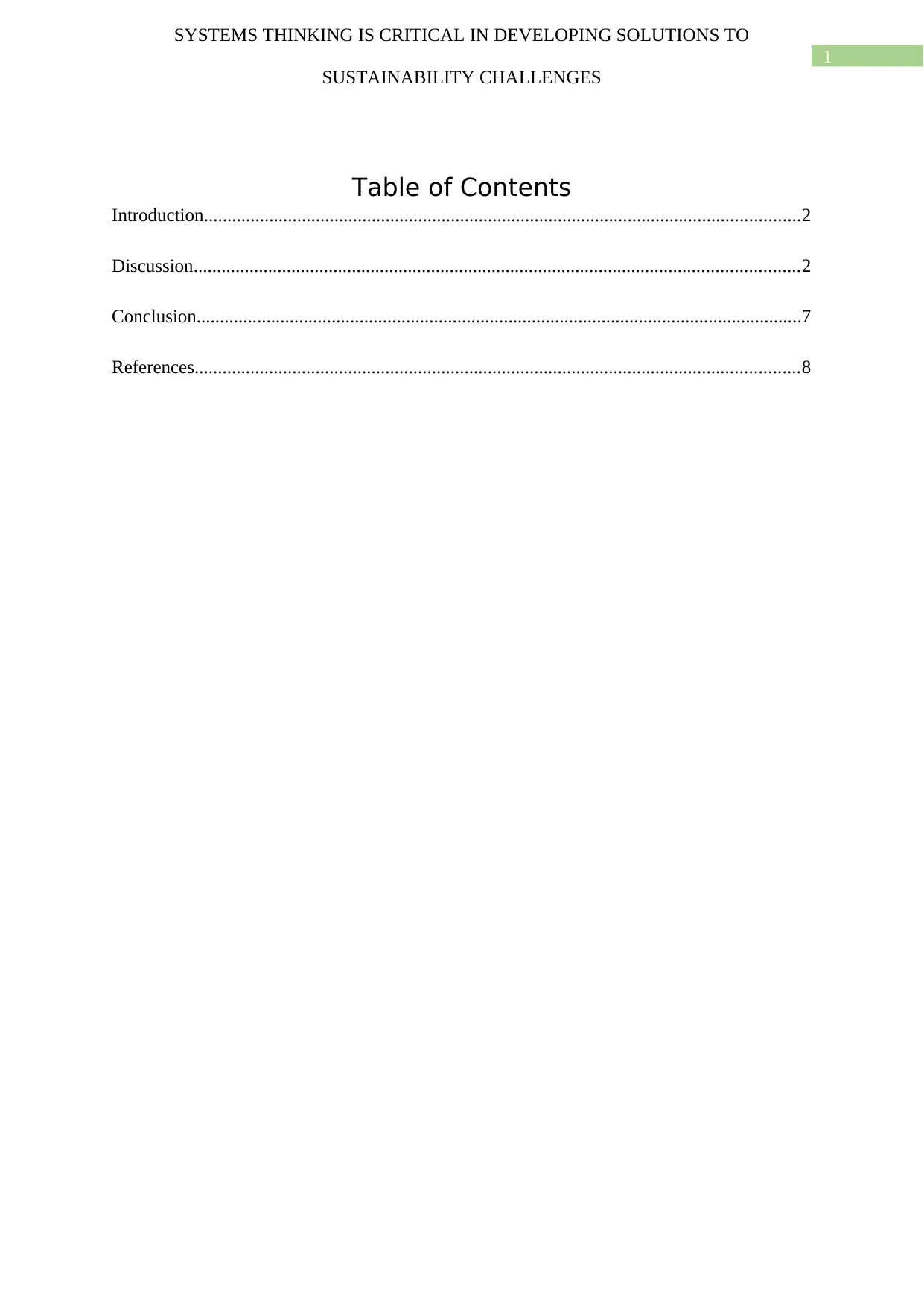
1
SYSTEMS THINKING IS CRITICAL IN DEVELOPING SOLUTIONS TO
SUSTAINABILITY CHALLENGES
Table of Contents
Introduction................................................................................................................................2
Discussion..................................................................................................................................2
Conclusion..................................................................................................................................7
References..................................................................................................................................8
SYSTEMS THINKING IS CRITICAL IN DEVELOPING SOLUTIONS TO
SUSTAINABILITY CHALLENGES
Table of Contents
Introduction................................................................................................................................2
Discussion..................................................................................................................................2
Conclusion..................................................................................................................................7
References..................................................................................................................................8
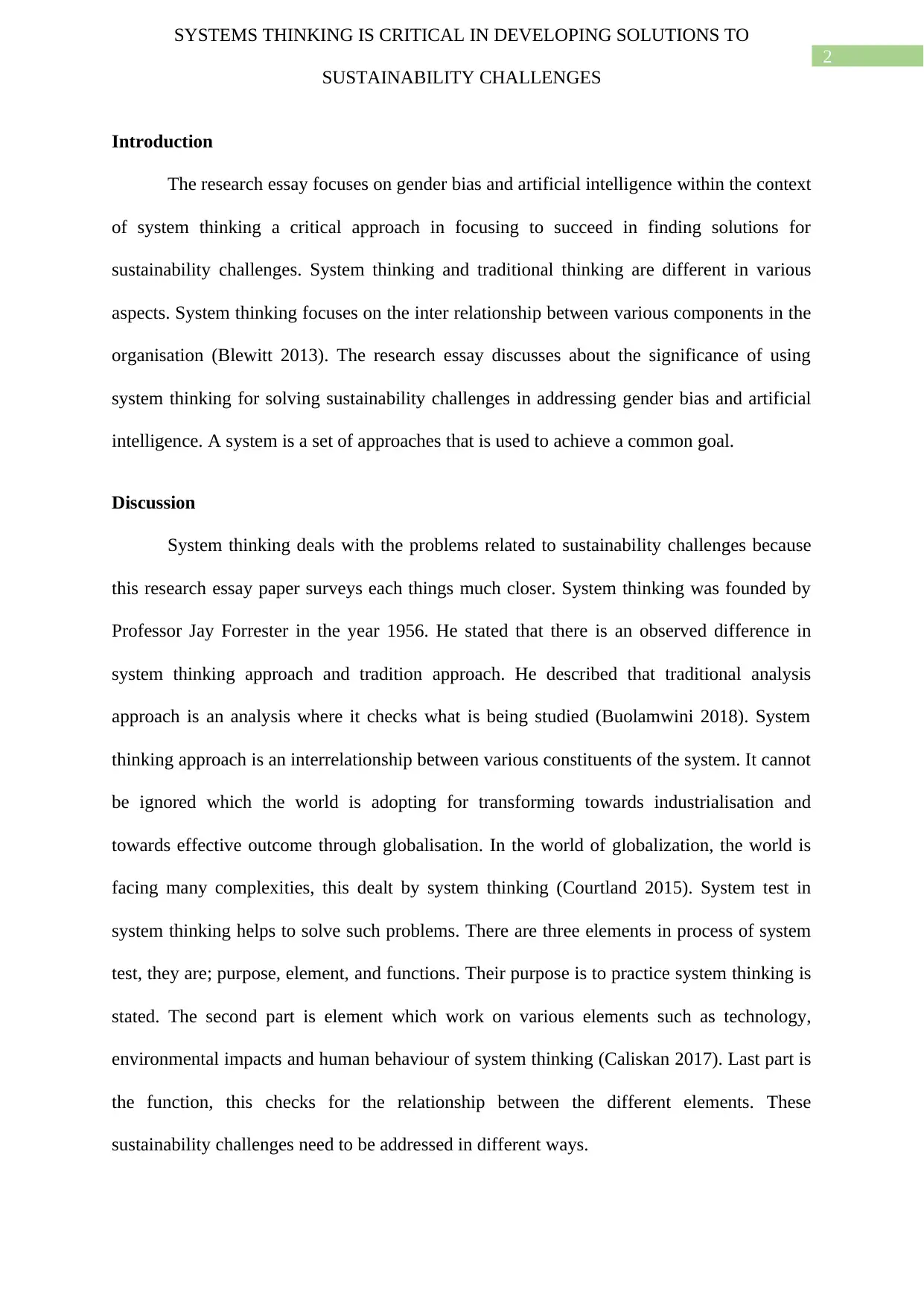
2
SYSTEMS THINKING IS CRITICAL IN DEVELOPING SOLUTIONS TO
SUSTAINABILITY CHALLENGES
Introduction
The research essay focuses on gender bias and artificial intelligence within the context
of system thinking a critical approach in focusing to succeed in finding solutions for
sustainability challenges. System thinking and traditional thinking are different in various
aspects. System thinking focuses on the inter relationship between various components in the
organisation (Blewitt 2013). The research essay discusses about the significance of using
system thinking for solving sustainability challenges in addressing gender bias and artificial
intelligence. A system is a set of approaches that is used to achieve a common goal.
Discussion
System thinking deals with the problems related to sustainability challenges because
this research essay paper surveys each things much closer. System thinking was founded by
Professor Jay Forrester in the year 1956. He stated that there is an observed difference in
system thinking approach and tradition approach. He described that traditional analysis
approach is an analysis where it checks what is being studied (Buolamwini 2018). System
thinking approach is an interrelationship between various constituents of the system. It cannot
be ignored which the world is adopting for transforming towards industrialisation and
towards effective outcome through globalisation. In the world of globalization, the world is
facing many complexities, this dealt by system thinking (Courtland 2015). System test in
system thinking helps to solve such problems. There are three elements in process of system
test, they are; purpose, element, and functions. Their purpose is to practice system thinking is
stated. The second part is element which work on various elements such as technology,
environmental impacts and human behaviour of system thinking (Caliskan 2017). Last part is
the function, this checks for the relationship between the different elements. These
sustainability challenges need to be addressed in different ways.
SYSTEMS THINKING IS CRITICAL IN DEVELOPING SOLUTIONS TO
SUSTAINABILITY CHALLENGES
Introduction
The research essay focuses on gender bias and artificial intelligence within the context
of system thinking a critical approach in focusing to succeed in finding solutions for
sustainability challenges. System thinking and traditional thinking are different in various
aspects. System thinking focuses on the inter relationship between various components in the
organisation (Blewitt 2013). The research essay discusses about the significance of using
system thinking for solving sustainability challenges in addressing gender bias and artificial
intelligence. A system is a set of approaches that is used to achieve a common goal.
Discussion
System thinking deals with the problems related to sustainability challenges because
this research essay paper surveys each things much closer. System thinking was founded by
Professor Jay Forrester in the year 1956. He stated that there is an observed difference in
system thinking approach and tradition approach. He described that traditional analysis
approach is an analysis where it checks what is being studied (Buolamwini 2018). System
thinking approach is an interrelationship between various constituents of the system. It cannot
be ignored which the world is adopting for transforming towards industrialisation and
towards effective outcome through globalisation. In the world of globalization, the world is
facing many complexities, this dealt by system thinking (Courtland 2015). System test in
system thinking helps to solve such problems. There are three elements in process of system
test, they are; purpose, element, and functions. Their purpose is to practice system thinking is
stated. The second part is element which work on various elements such as technology,
environmental impacts and human behaviour of system thinking (Caliskan 2017). Last part is
the function, this checks for the relationship between the different elements. These
sustainability challenges need to be addressed in different ways.
⊘ This is a preview!⊘
Do you want full access?
Subscribe today to unlock all pages.

Trusted by 1+ million students worldwide
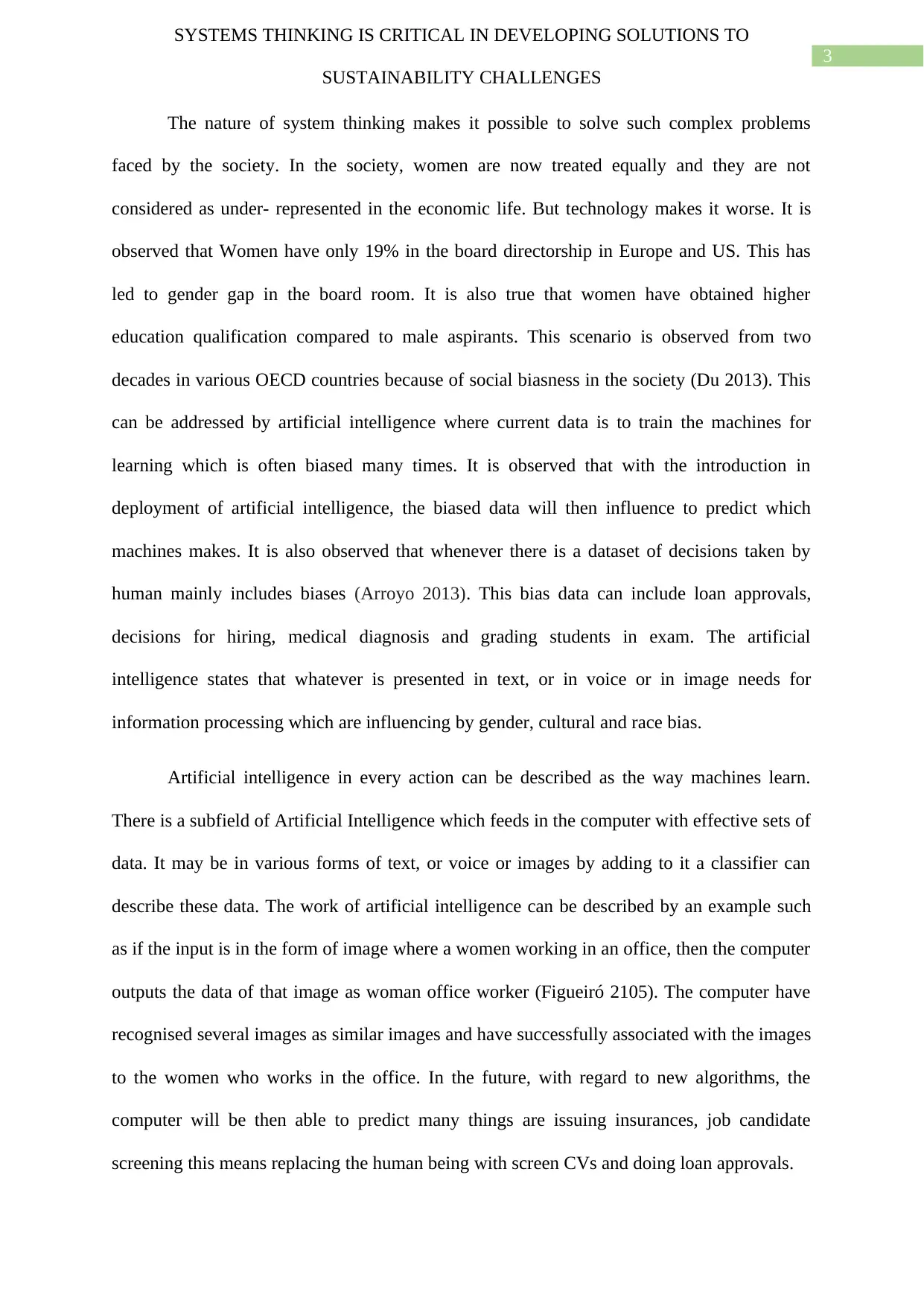
3
SYSTEMS THINKING IS CRITICAL IN DEVELOPING SOLUTIONS TO
SUSTAINABILITY CHALLENGES
The nature of system thinking makes it possible to solve such complex problems
faced by the society. In the society, women are now treated equally and they are not
considered as under- represented in the economic life. But technology makes it worse. It is
observed that Women have only 19% in the board directorship in Europe and US. This has
led to gender gap in the board room. It is also true that women have obtained higher
education qualification compared to male aspirants. This scenario is observed from two
decades in various OECD countries because of social biasness in the society (Du 2013). This
can be addressed by artificial intelligence where current data is to train the machines for
learning which is often biased many times. It is observed that with the introduction in
deployment of artificial intelligence, the biased data will then influence to predict which
machines makes. It is also observed that whenever there is a dataset of decisions taken by
human mainly includes biases (Arroyo 2013). This bias data can include loan approvals,
decisions for hiring, medical diagnosis and grading students in exam. The artificial
intelligence states that whatever is presented in text, or in voice or in image needs for
information processing which are influencing by gender, cultural and race bias.
Artificial intelligence in every action can be described as the way machines learn.
There is a subfield of Artificial Intelligence which feeds in the computer with effective sets of
data. It may be in various forms of text, or voice or images by adding to it a classifier can
describe these data. The work of artificial intelligence can be described by an example such
as if the input is in the form of image where a women working in an office, then the computer
outputs the data of that image as woman office worker (Figueiró 2105). The computer have
recognised several images as similar images and have successfully associated with the images
to the women who works in the office. In the future, with regard to new algorithms, the
computer will be then able to predict many things are issuing insurances, job candidate
screening this means replacing the human being with screen CVs and doing loan approvals.
SYSTEMS THINKING IS CRITICAL IN DEVELOPING SOLUTIONS TO
SUSTAINABILITY CHALLENGES
The nature of system thinking makes it possible to solve such complex problems
faced by the society. In the society, women are now treated equally and they are not
considered as under- represented in the economic life. But technology makes it worse. It is
observed that Women have only 19% in the board directorship in Europe and US. This has
led to gender gap in the board room. It is also true that women have obtained higher
education qualification compared to male aspirants. This scenario is observed from two
decades in various OECD countries because of social biasness in the society (Du 2013). This
can be addressed by artificial intelligence where current data is to train the machines for
learning which is often biased many times. It is observed that with the introduction in
deployment of artificial intelligence, the biased data will then influence to predict which
machines makes. It is also observed that whenever there is a dataset of decisions taken by
human mainly includes biases (Arroyo 2013). This bias data can include loan approvals,
decisions for hiring, medical diagnosis and grading students in exam. The artificial
intelligence states that whatever is presented in text, or in voice or in image needs for
information processing which are influencing by gender, cultural and race bias.
Artificial intelligence in every action can be described as the way machines learn.
There is a subfield of Artificial Intelligence which feeds in the computer with effective sets of
data. It may be in various forms of text, or voice or images by adding to it a classifier can
describe these data. The work of artificial intelligence can be described by an example such
as if the input is in the form of image where a women working in an office, then the computer
outputs the data of that image as woman office worker (Figueiró 2105). The computer have
recognised several images as similar images and have successfully associated with the images
to the women who works in the office. In the future, with regard to new algorithms, the
computer will be then able to predict many things are issuing insurances, job candidate
screening this means replacing the human being with screen CVs and doing loan approvals.
Paraphrase This Document
Need a fresh take? Get an instant paraphrase of this document with our AI Paraphraser
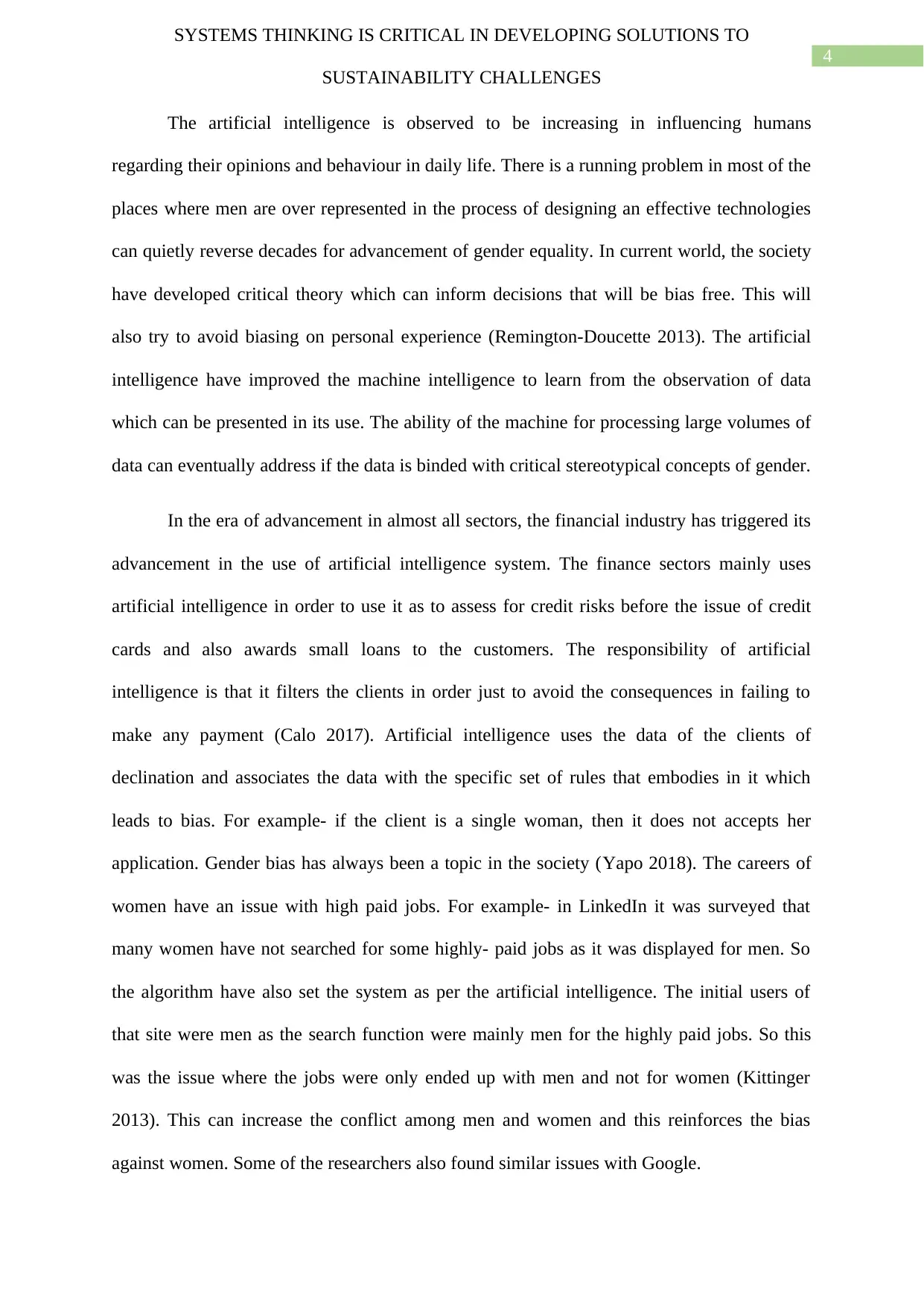
4
SYSTEMS THINKING IS CRITICAL IN DEVELOPING SOLUTIONS TO
SUSTAINABILITY CHALLENGES
The artificial intelligence is observed to be increasing in influencing humans
regarding their opinions and behaviour in daily life. There is a running problem in most of the
places where men are over represented in the process of designing an effective technologies
can quietly reverse decades for advancement of gender equality. In current world, the society
have developed critical theory which can inform decisions that will be bias free. This will
also try to avoid biasing on personal experience (Remington-Doucette 2013). The artificial
intelligence have improved the machine intelligence to learn from the observation of data
which can be presented in its use. The ability of the machine for processing large volumes of
data can eventually address if the data is binded with critical stereotypical concepts of gender.
In the era of advancement in almost all sectors, the financial industry has triggered its
advancement in the use of artificial intelligence system. The finance sectors mainly uses
artificial intelligence in order to use it as to assess for credit risks before the issue of credit
cards and also awards small loans to the customers. The responsibility of artificial
intelligence is that it filters the clients in order just to avoid the consequences in failing to
make any payment (Calo 2017). Artificial intelligence uses the data of the clients of
declination and associates the data with the specific set of rules that embodies in it which
leads to bias. For example- if the client is a single woman, then it does not accepts her
application. Gender bias has always been a topic in the society (Yapo 2018). The careers of
women have an issue with high paid jobs. For example- in LinkedIn it was surveyed that
many women have not searched for some highly- paid jobs as it was displayed for men. So
the algorithm have also set the system as per the artificial intelligence. The initial users of
that site were men as the search function were mainly men for the highly paid jobs. So this
was the issue where the jobs were only ended up with men and not for women (Kittinger
2013). This can increase the conflict among men and women and this reinforces the bias
against women. Some of the researchers also found similar issues with Google.
SYSTEMS THINKING IS CRITICAL IN DEVELOPING SOLUTIONS TO
SUSTAINABILITY CHALLENGES
The artificial intelligence is observed to be increasing in influencing humans
regarding their opinions and behaviour in daily life. There is a running problem in most of the
places where men are over represented in the process of designing an effective technologies
can quietly reverse decades for advancement of gender equality. In current world, the society
have developed critical theory which can inform decisions that will be bias free. This will
also try to avoid biasing on personal experience (Remington-Doucette 2013). The artificial
intelligence have improved the machine intelligence to learn from the observation of data
which can be presented in its use. The ability of the machine for processing large volumes of
data can eventually address if the data is binded with critical stereotypical concepts of gender.
In the era of advancement in almost all sectors, the financial industry has triggered its
advancement in the use of artificial intelligence system. The finance sectors mainly uses
artificial intelligence in order to use it as to assess for credit risks before the issue of credit
cards and also awards small loans to the customers. The responsibility of artificial
intelligence is that it filters the clients in order just to avoid the consequences in failing to
make any payment (Calo 2017). Artificial intelligence uses the data of the clients of
declination and associates the data with the specific set of rules that embodies in it which
leads to bias. For example- if the client is a single woman, then it does not accepts her
application. Gender bias has always been a topic in the society (Yapo 2018). The careers of
women have an issue with high paid jobs. For example- in LinkedIn it was surveyed that
many women have not searched for some highly- paid jobs as it was displayed for men. So
the algorithm have also set the system as per the artificial intelligence. The initial users of
that site were men as the search function were mainly men for the highly paid jobs. So this
was the issue where the jobs were only ended up with men and not for women (Kittinger
2013). This can increase the conflict among men and women and this reinforces the bias
against women. Some of the researchers also found similar issues with Google.
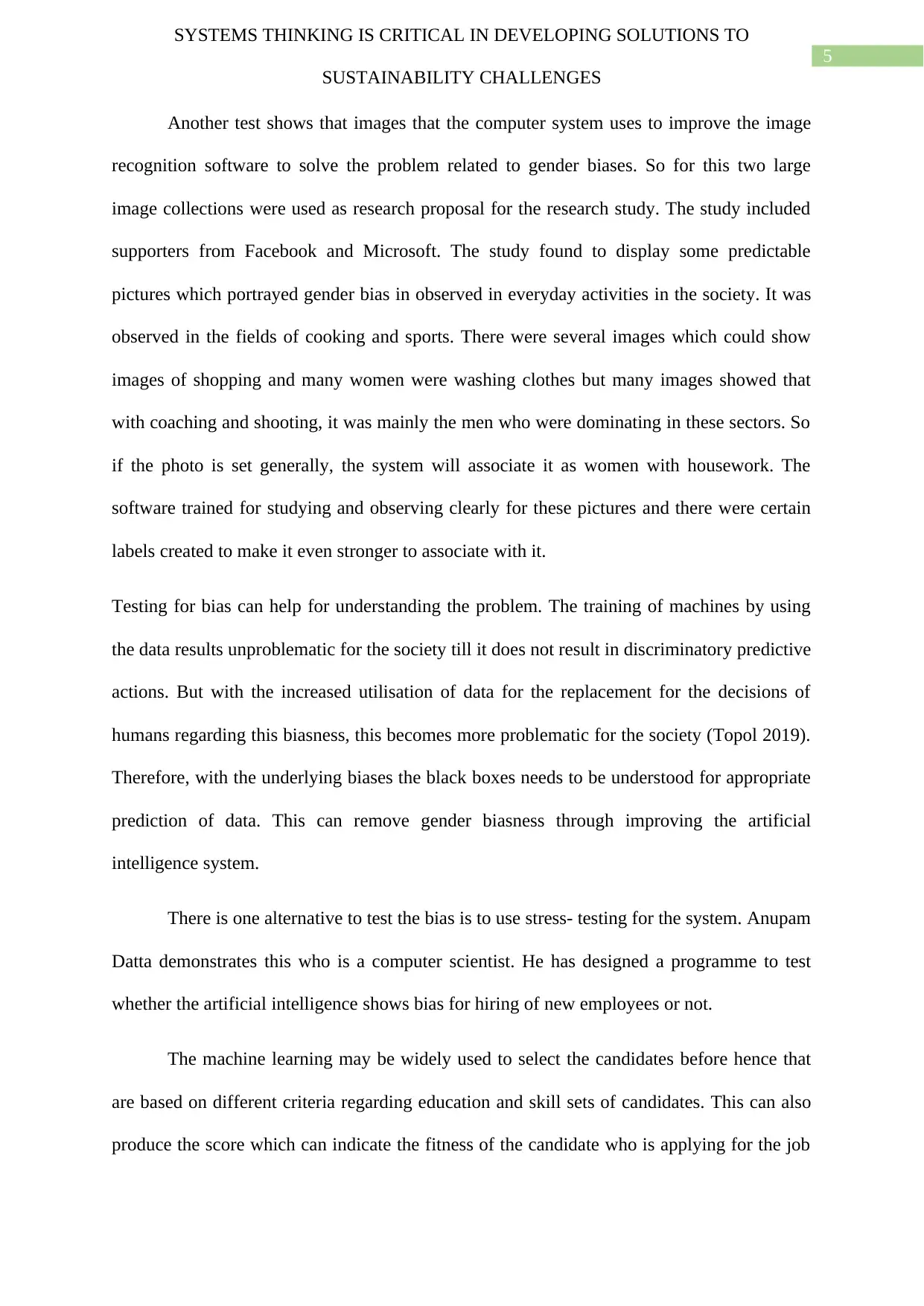
5
SYSTEMS THINKING IS CRITICAL IN DEVELOPING SOLUTIONS TO
SUSTAINABILITY CHALLENGES
Another test shows that images that the computer system uses to improve the image
recognition software to solve the problem related to gender biases. So for this two large
image collections were used as research proposal for the research study. The study included
supporters from Facebook and Microsoft. The study found to display some predictable
pictures which portrayed gender bias in observed in everyday activities in the society. It was
observed in the fields of cooking and sports. There were several images which could show
images of shopping and many women were washing clothes but many images showed that
with coaching and shooting, it was mainly the men who were dominating in these sectors. So
if the photo is set generally, the system will associate it as women with housework. The
software trained for studying and observing clearly for these pictures and there were certain
labels created to make it even stronger to associate with it.
Testing for bias can help for understanding the problem. The training of machines by using
the data results unproblematic for the society till it does not result in discriminatory predictive
actions. But with the increased utilisation of data for the replacement for the decisions of
humans regarding this biasness, this becomes more problematic for the society (Topol 2019).
Therefore, with the underlying biases the black boxes needs to be understood for appropriate
prediction of data. This can remove gender biasness through improving the artificial
intelligence system.
There is one alternative to test the bias is to use stress- testing for the system. Anupam
Datta demonstrates this who is a computer scientist. He has designed a programme to test
whether the artificial intelligence shows bias for hiring of new employees or not.
The machine learning may be widely used to select the candidates before hence that
are based on different criteria regarding education and skill sets of candidates. This can also
produce the score which can indicate the fitness of the candidate who is applying for the job
SYSTEMS THINKING IS CRITICAL IN DEVELOPING SOLUTIONS TO
SUSTAINABILITY CHALLENGES
Another test shows that images that the computer system uses to improve the image
recognition software to solve the problem related to gender biases. So for this two large
image collections were used as research proposal for the research study. The study included
supporters from Facebook and Microsoft. The study found to display some predictable
pictures which portrayed gender bias in observed in everyday activities in the society. It was
observed in the fields of cooking and sports. There were several images which could show
images of shopping and many women were washing clothes but many images showed that
with coaching and shooting, it was mainly the men who were dominating in these sectors. So
if the photo is set generally, the system will associate it as women with housework. The
software trained for studying and observing clearly for these pictures and there were certain
labels created to make it even stronger to associate with it.
Testing for bias can help for understanding the problem. The training of machines by using
the data results unproblematic for the society till it does not result in discriminatory predictive
actions. But with the increased utilisation of data for the replacement for the decisions of
humans regarding this biasness, this becomes more problematic for the society (Topol 2019).
Therefore, with the underlying biases the black boxes needs to be understood for appropriate
prediction of data. This can remove gender biasness through improving the artificial
intelligence system.
There is one alternative to test the bias is to use stress- testing for the system. Anupam
Datta demonstrates this who is a computer scientist. He has designed a programme to test
whether the artificial intelligence shows bias for hiring of new employees or not.
The machine learning may be widely used to select the candidates before hence that
are based on different criteria regarding education and skill sets of candidates. This can also
produce the score which can indicate the fitness of the candidate who is applying for the job
⊘ This is a preview!⊘
Do you want full access?
Subscribe today to unlock all pages.

Trusted by 1+ million students worldwide
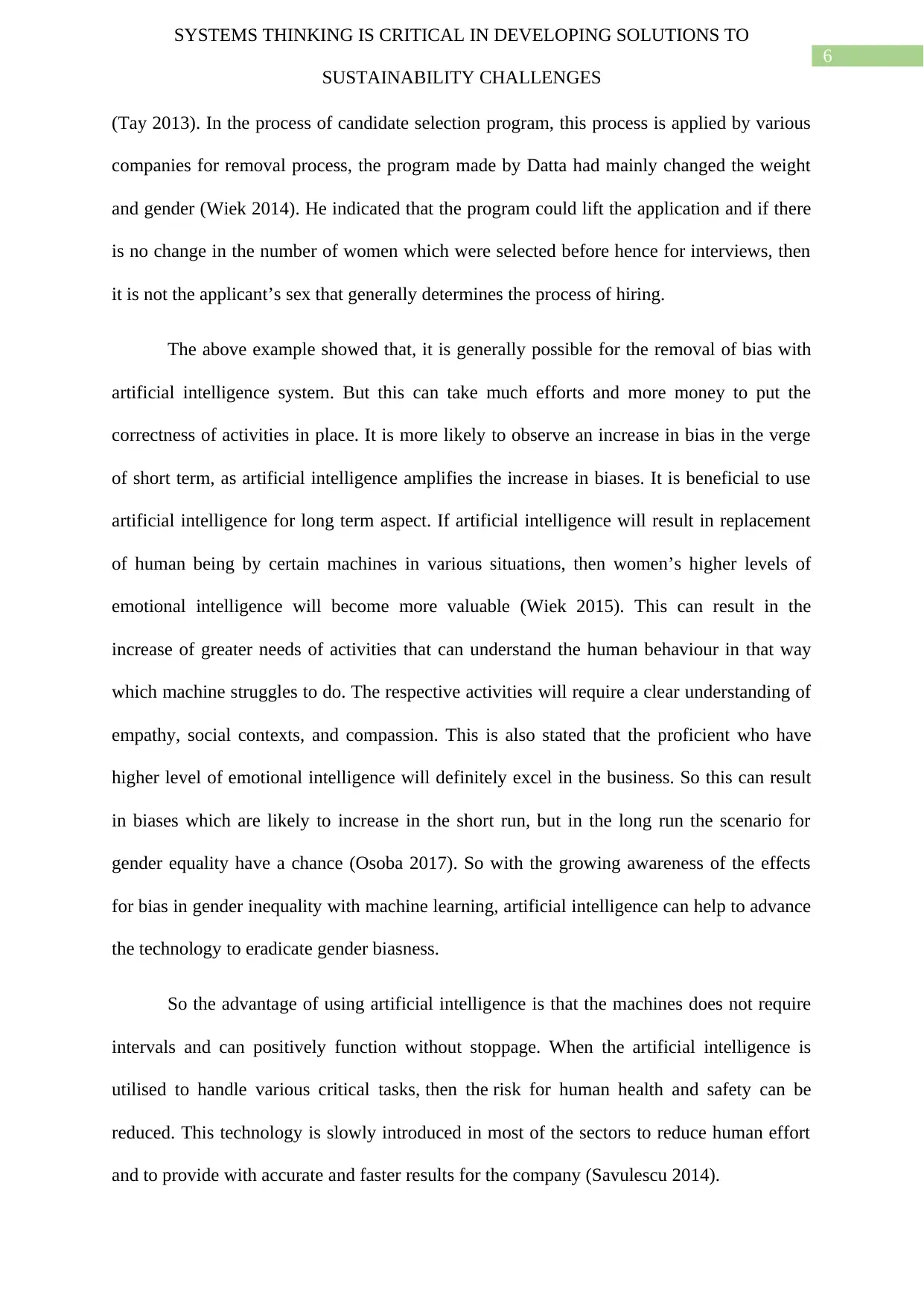
6
SYSTEMS THINKING IS CRITICAL IN DEVELOPING SOLUTIONS TO
SUSTAINABILITY CHALLENGES
(Tay 2013). In the process of candidate selection program, this process is applied by various
companies for removal process, the program made by Datta had mainly changed the weight
and gender (Wiek 2014). He indicated that the program could lift the application and if there
is no change in the number of women which were selected before hence for interviews, then
it is not the applicant’s sex that generally determines the process of hiring.
The above example showed that, it is generally possible for the removal of bias with
artificial intelligence system. But this can take much efforts and more money to put the
correctness of activities in place. It is more likely to observe an increase in bias in the verge
of short term, as artificial intelligence amplifies the increase in biases. It is beneficial to use
artificial intelligence for long term aspect. If artificial intelligence will result in replacement
of human being by certain machines in various situations, then women’s higher levels of
emotional intelligence will become more valuable (Wiek 2015). This can result in the
increase of greater needs of activities that can understand the human behaviour in that way
which machine struggles to do. The respective activities will require a clear understanding of
empathy, social contexts, and compassion. This is also stated that the proficient who have
higher level of emotional intelligence will definitely excel in the business. So this can result
in biases which are likely to increase in the short run, but in the long run the scenario for
gender equality have a chance (Osoba 2017). So with the growing awareness of the effects
for bias in gender inequality with machine learning, artificial intelligence can help to advance
the technology to eradicate gender biasness.
So the advantage of using artificial intelligence is that the machines does not require
intervals and can positively function without stoppage. When the artificial intelligence is
utilised to handle various critical tasks, then the risk for human health and safety can be
reduced. This technology is slowly introduced in most of the sectors to reduce human effort
and to provide with accurate and faster results for the company (Savulescu 2014).
SYSTEMS THINKING IS CRITICAL IN DEVELOPING SOLUTIONS TO
SUSTAINABILITY CHALLENGES
(Tay 2013). In the process of candidate selection program, this process is applied by various
companies for removal process, the program made by Datta had mainly changed the weight
and gender (Wiek 2014). He indicated that the program could lift the application and if there
is no change in the number of women which were selected before hence for interviews, then
it is not the applicant’s sex that generally determines the process of hiring.
The above example showed that, it is generally possible for the removal of bias with
artificial intelligence system. But this can take much efforts and more money to put the
correctness of activities in place. It is more likely to observe an increase in bias in the verge
of short term, as artificial intelligence amplifies the increase in biases. It is beneficial to use
artificial intelligence for long term aspect. If artificial intelligence will result in replacement
of human being by certain machines in various situations, then women’s higher levels of
emotional intelligence will become more valuable (Wiek 2015). This can result in the
increase of greater needs of activities that can understand the human behaviour in that way
which machine struggles to do. The respective activities will require a clear understanding of
empathy, social contexts, and compassion. This is also stated that the proficient who have
higher level of emotional intelligence will definitely excel in the business. So this can result
in biases which are likely to increase in the short run, but in the long run the scenario for
gender equality have a chance (Osoba 2017). So with the growing awareness of the effects
for bias in gender inequality with machine learning, artificial intelligence can help to advance
the technology to eradicate gender biasness.
So the advantage of using artificial intelligence is that the machines does not require
intervals and can positively function without stoppage. When the artificial intelligence is
utilised to handle various critical tasks, then the risk for human health and safety can be
reduced. This technology is slowly introduced in most of the sectors to reduce human effort
and to provide with accurate and faster results for the company (Savulescu 2014).
Paraphrase This Document
Need a fresh take? Get an instant paraphrase of this document with our AI Paraphraser
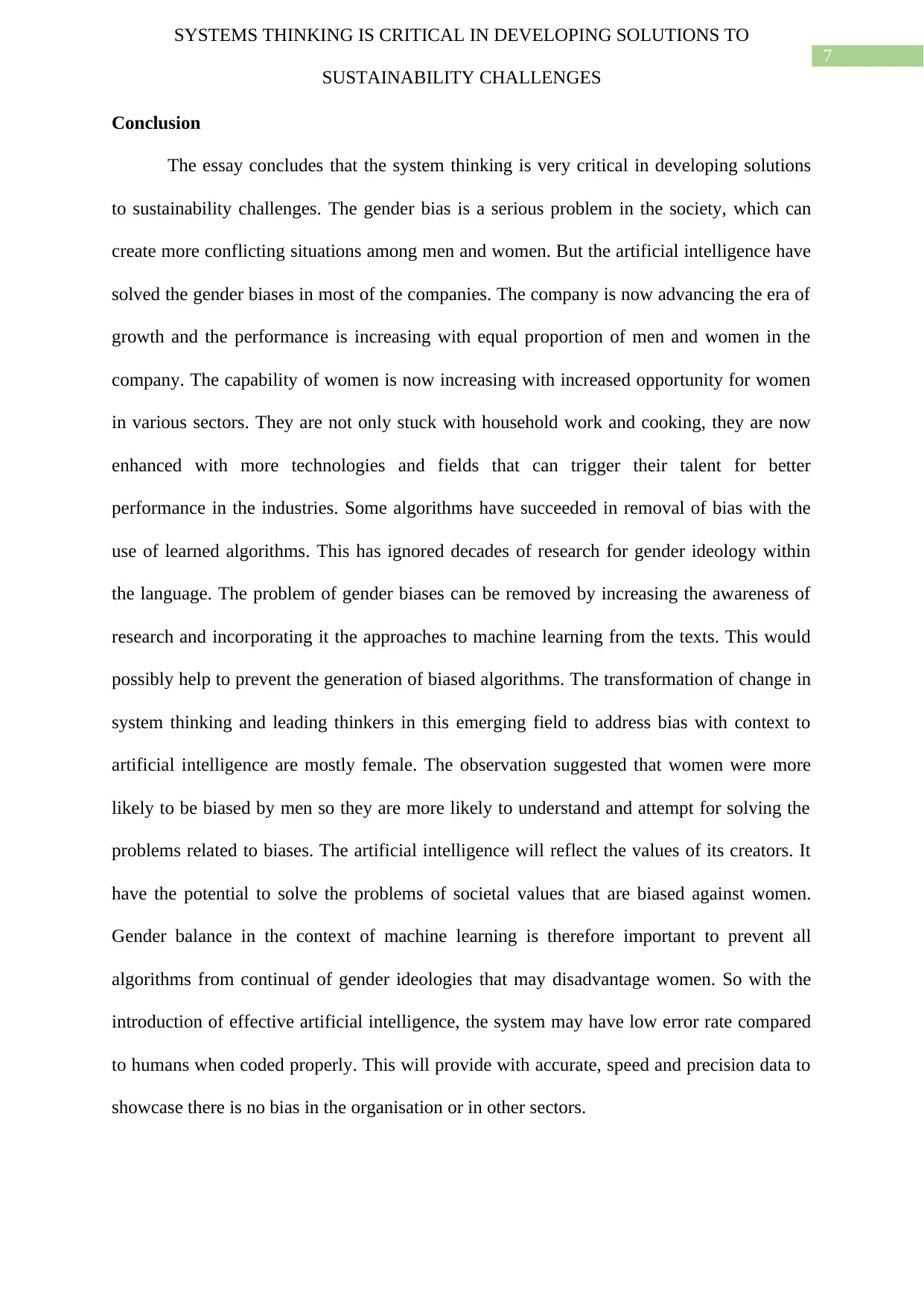
7
SYSTEMS THINKING IS CRITICAL IN DEVELOPING SOLUTIONS TO
SUSTAINABILITY CHALLENGES
Conclusion
The essay concludes that the system thinking is very critical in developing solutions
to sustainability challenges. The gender bias is a serious problem in the society, which can
create more conflicting situations among men and women. But the artificial intelligence have
solved the gender biases in most of the companies. The company is now advancing the era of
growth and the performance is increasing with equal proportion of men and women in the
company. The capability of women is now increasing with increased opportunity for women
in various sectors. They are not only stuck with household work and cooking, they are now
enhanced with more technologies and fields that can trigger their talent for better
performance in the industries. Some algorithms have succeeded in removal of bias with the
use of learned algorithms. This has ignored decades of research for gender ideology within
the language. The problem of gender biases can be removed by increasing the awareness of
research and incorporating it the approaches to machine learning from the texts. This would
possibly help to prevent the generation of biased algorithms. The transformation of change in
system thinking and leading thinkers in this emerging field to address bias with context to
artificial intelligence are mostly female. The observation suggested that women were more
likely to be biased by men so they are more likely to understand and attempt for solving the
problems related to biases. The artificial intelligence will reflect the values of its creators. It
have the potential to solve the problems of societal values that are biased against women.
Gender balance in the context of machine learning is therefore important to prevent all
algorithms from continual of gender ideologies that may disadvantage women. So with the
introduction of effective artificial intelligence, the system may have low error rate compared
to humans when coded properly. This will provide with accurate, speed and precision data to
showcase there is no bias in the organisation or in other sectors.
SYSTEMS THINKING IS CRITICAL IN DEVELOPING SOLUTIONS TO
SUSTAINABILITY CHALLENGES
Conclusion
The essay concludes that the system thinking is very critical in developing solutions
to sustainability challenges. The gender bias is a serious problem in the society, which can
create more conflicting situations among men and women. But the artificial intelligence have
solved the gender biases in most of the companies. The company is now advancing the era of
growth and the performance is increasing with equal proportion of men and women in the
company. The capability of women is now increasing with increased opportunity for women
in various sectors. They are not only stuck with household work and cooking, they are now
enhanced with more technologies and fields that can trigger their talent for better
performance in the industries. Some algorithms have succeeded in removal of bias with the
use of learned algorithms. This has ignored decades of research for gender ideology within
the language. The problem of gender biases can be removed by increasing the awareness of
research and incorporating it the approaches to machine learning from the texts. This would
possibly help to prevent the generation of biased algorithms. The transformation of change in
system thinking and leading thinkers in this emerging field to address bias with context to
artificial intelligence are mostly female. The observation suggested that women were more
likely to be biased by men so they are more likely to understand and attempt for solving the
problems related to biases. The artificial intelligence will reflect the values of its creators. It
have the potential to solve the problems of societal values that are biased against women.
Gender balance in the context of machine learning is therefore important to prevent all
algorithms from continual of gender ideologies that may disadvantage women. So with the
introduction of effective artificial intelligence, the system may have low error rate compared
to humans when coded properly. This will provide with accurate, speed and precision data to
showcase there is no bias in the organisation or in other sectors.
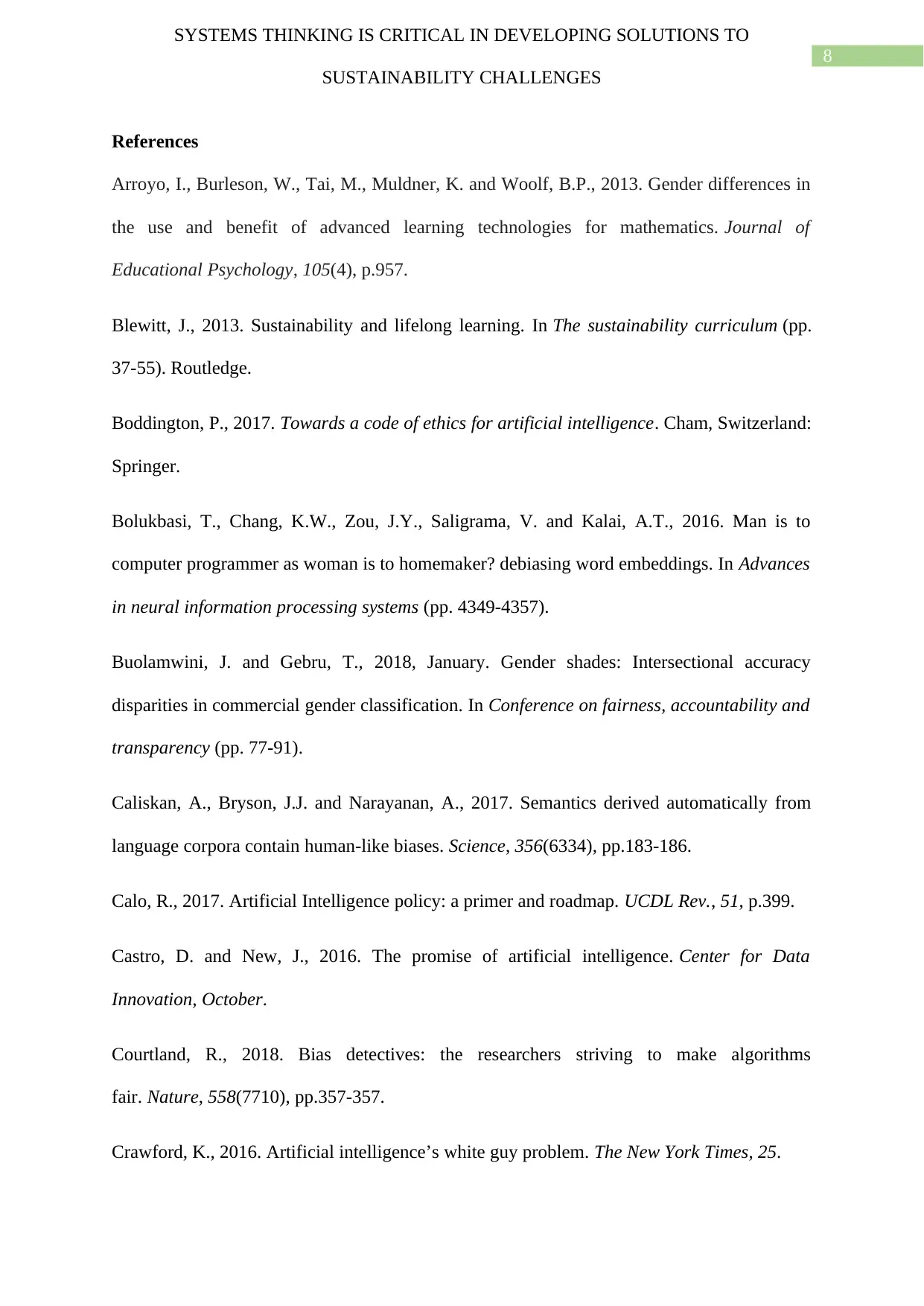
8
SYSTEMS THINKING IS CRITICAL IN DEVELOPING SOLUTIONS TO
SUSTAINABILITY CHALLENGES
References
Arroyo, I., Burleson, W., Tai, M., Muldner, K. and Woolf, B.P., 2013. Gender differences in
the use and benefit of advanced learning technologies for mathematics. Journal of
Educational Psychology, 105(4), p.957.
Blewitt, J., 2013. Sustainability and lifelong learning. In The sustainability curriculum (pp.
37-55). Routledge.
Boddington, P., 2017. Towards a code of ethics for artificial intelligence. Cham, Switzerland:
Springer.
Bolukbasi, T., Chang, K.W., Zou, J.Y., Saligrama, V. and Kalai, A.T., 2016. Man is to
computer programmer as woman is to homemaker? debiasing word embeddings. In Advances
in neural information processing systems (pp. 4349-4357).
Buolamwini, J. and Gebru, T., 2018, January. Gender shades: Intersectional accuracy
disparities in commercial gender classification. In Conference on fairness, accountability and
transparency (pp. 77-91).
Caliskan, A., Bryson, J.J. and Narayanan, A., 2017. Semantics derived automatically from
language corpora contain human-like biases. Science, 356(6334), pp.183-186.
Calo, R., 2017. Artificial Intelligence policy: a primer and roadmap. UCDL Rev., 51, p.399.
Castro, D. and New, J., 2016. The promise of artificial intelligence. Center for Data
Innovation, October.
Courtland, R., 2018. Bias detectives: the researchers striving to make algorithms
fair. Nature, 558(7710), pp.357-357.
Crawford, K., 2016. Artificial intelligence’s white guy problem. The New York Times, 25.
SYSTEMS THINKING IS CRITICAL IN DEVELOPING SOLUTIONS TO
SUSTAINABILITY CHALLENGES
References
Arroyo, I., Burleson, W., Tai, M., Muldner, K. and Woolf, B.P., 2013. Gender differences in
the use and benefit of advanced learning technologies for mathematics. Journal of
Educational Psychology, 105(4), p.957.
Blewitt, J., 2013. Sustainability and lifelong learning. In The sustainability curriculum (pp.
37-55). Routledge.
Boddington, P., 2017. Towards a code of ethics for artificial intelligence. Cham, Switzerland:
Springer.
Bolukbasi, T., Chang, K.W., Zou, J.Y., Saligrama, V. and Kalai, A.T., 2016. Man is to
computer programmer as woman is to homemaker? debiasing word embeddings. In Advances
in neural information processing systems (pp. 4349-4357).
Buolamwini, J. and Gebru, T., 2018, January. Gender shades: Intersectional accuracy
disparities in commercial gender classification. In Conference on fairness, accountability and
transparency (pp. 77-91).
Caliskan, A., Bryson, J.J. and Narayanan, A., 2017. Semantics derived automatically from
language corpora contain human-like biases. Science, 356(6334), pp.183-186.
Calo, R., 2017. Artificial Intelligence policy: a primer and roadmap. UCDL Rev., 51, p.399.
Castro, D. and New, J., 2016. The promise of artificial intelligence. Center for Data
Innovation, October.
Courtland, R., 2018. Bias detectives: the researchers striving to make algorithms
fair. Nature, 558(7710), pp.357-357.
Crawford, K., 2016. Artificial intelligence’s white guy problem. The New York Times, 25.
⊘ This is a preview!⊘
Do you want full access?
Subscribe today to unlock all pages.

Trusted by 1+ million students worldwide
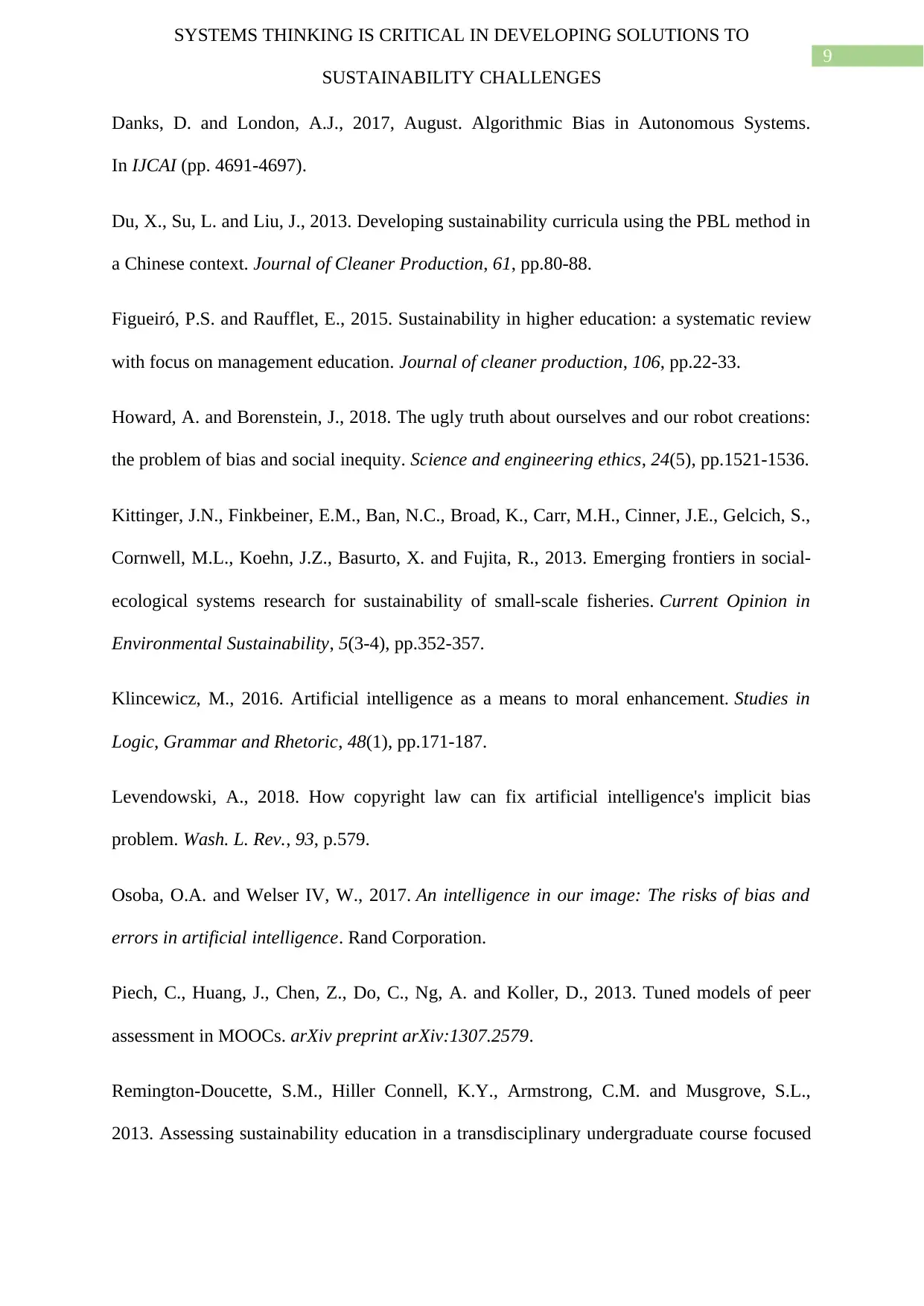
9
SYSTEMS THINKING IS CRITICAL IN DEVELOPING SOLUTIONS TO
SUSTAINABILITY CHALLENGES
Danks, D. and London, A.J., 2017, August. Algorithmic Bias in Autonomous Systems.
In IJCAI (pp. 4691-4697).
Du, X., Su, L. and Liu, J., 2013. Developing sustainability curricula using the PBL method in
a Chinese context. Journal of Cleaner Production, 61, pp.80-88.
Figueiró, P.S. and Raufflet, E., 2015. Sustainability in higher education: a systematic review
with focus on management education. Journal of cleaner production, 106, pp.22-33.
Howard, A. and Borenstein, J., 2018. The ugly truth about ourselves and our robot creations:
the problem of bias and social inequity. Science and engineering ethics, 24(5), pp.1521-1536.
Kittinger, J.N., Finkbeiner, E.M., Ban, N.C., Broad, K., Carr, M.H., Cinner, J.E., Gelcich, S.,
Cornwell, M.L., Koehn, J.Z., Basurto, X. and Fujita, R., 2013. Emerging frontiers in social-
ecological systems research for sustainability of small-scale fisheries. Current Opinion in
Environmental Sustainability, 5(3-4), pp.352-357.
Klincewicz, M., 2016. Artificial intelligence as a means to moral enhancement. Studies in
Logic, Grammar and Rhetoric, 48(1), pp.171-187.
Levendowski, A., 2018. How copyright law can fix artificial intelligence's implicit bias
problem. Wash. L. Rev., 93, p.579.
Osoba, O.A. and Welser IV, W., 2017. An intelligence in our image: The risks of bias and
errors in artificial intelligence. Rand Corporation.
Piech, C., Huang, J., Chen, Z., Do, C., Ng, A. and Koller, D., 2013. Tuned models of peer
assessment in MOOCs. arXiv preprint arXiv:1307.2579.
Remington-Doucette, S.M., Hiller Connell, K.Y., Armstrong, C.M. and Musgrove, S.L.,
2013. Assessing sustainability education in a transdisciplinary undergraduate course focused
SYSTEMS THINKING IS CRITICAL IN DEVELOPING SOLUTIONS TO
SUSTAINABILITY CHALLENGES
Danks, D. and London, A.J., 2017, August. Algorithmic Bias in Autonomous Systems.
In IJCAI (pp. 4691-4697).
Du, X., Su, L. and Liu, J., 2013. Developing sustainability curricula using the PBL method in
a Chinese context. Journal of Cleaner Production, 61, pp.80-88.
Figueiró, P.S. and Raufflet, E., 2015. Sustainability in higher education: a systematic review
with focus on management education. Journal of cleaner production, 106, pp.22-33.
Howard, A. and Borenstein, J., 2018. The ugly truth about ourselves and our robot creations:
the problem of bias and social inequity. Science and engineering ethics, 24(5), pp.1521-1536.
Kittinger, J.N., Finkbeiner, E.M., Ban, N.C., Broad, K., Carr, M.H., Cinner, J.E., Gelcich, S.,
Cornwell, M.L., Koehn, J.Z., Basurto, X. and Fujita, R., 2013. Emerging frontiers in social-
ecological systems research for sustainability of small-scale fisheries. Current Opinion in
Environmental Sustainability, 5(3-4), pp.352-357.
Klincewicz, M., 2016. Artificial intelligence as a means to moral enhancement. Studies in
Logic, Grammar and Rhetoric, 48(1), pp.171-187.
Levendowski, A., 2018. How copyright law can fix artificial intelligence's implicit bias
problem. Wash. L. Rev., 93, p.579.
Osoba, O.A. and Welser IV, W., 2017. An intelligence in our image: The risks of bias and
errors in artificial intelligence. Rand Corporation.
Piech, C., Huang, J., Chen, Z., Do, C., Ng, A. and Koller, D., 2013. Tuned models of peer
assessment in MOOCs. arXiv preprint arXiv:1307.2579.
Remington-Doucette, S.M., Hiller Connell, K.Y., Armstrong, C.M. and Musgrove, S.L.,
2013. Assessing sustainability education in a transdisciplinary undergraduate course focused
Paraphrase This Document
Need a fresh take? Get an instant paraphrase of this document with our AI Paraphraser
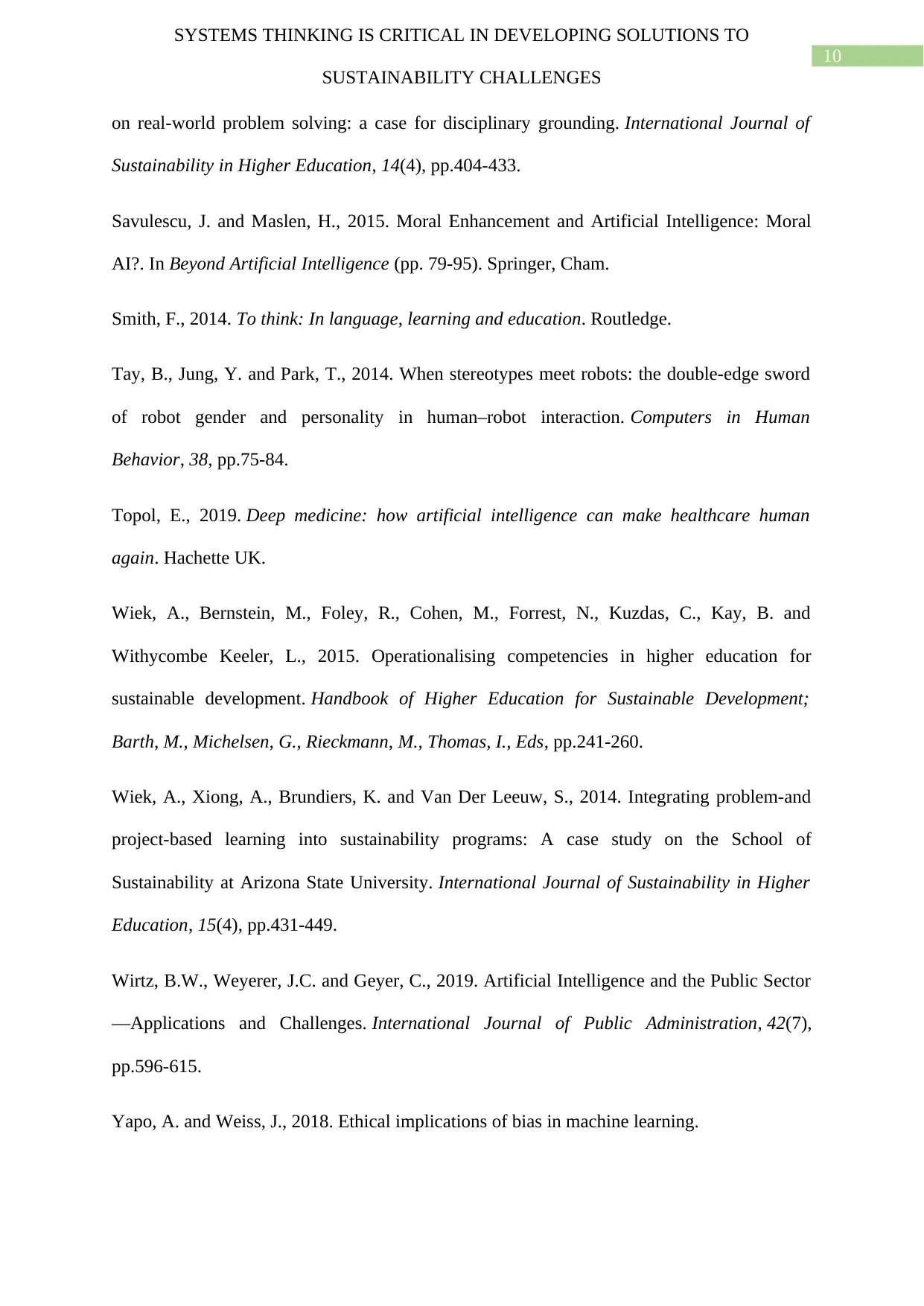
10
SYSTEMS THINKING IS CRITICAL IN DEVELOPING SOLUTIONS TO
SUSTAINABILITY CHALLENGES
on real-world problem solving: a case for disciplinary grounding. International Journal of
Sustainability in Higher Education, 14(4), pp.404-433.
Savulescu, J. and Maslen, H., 2015. Moral Enhancement and Artificial Intelligence: Moral
AI?. In Beyond Artificial Intelligence (pp. 79-95). Springer, Cham.
Smith, F., 2014. To think: In language, learning and education. Routledge.
Tay, B., Jung, Y. and Park, T., 2014. When stereotypes meet robots: the double-edge sword
of robot gender and personality in human–robot interaction. Computers in Human
Behavior, 38, pp.75-84.
Topol, E., 2019. Deep medicine: how artificial intelligence can make healthcare human
again. Hachette UK.
Wiek, A., Bernstein, M., Foley, R., Cohen, M., Forrest, N., Kuzdas, C., Kay, B. and
Withycombe Keeler, L., 2015. Operationalising competencies in higher education for
sustainable development. Handbook of Higher Education for Sustainable Development;
Barth, M., Michelsen, G., Rieckmann, M., Thomas, I., Eds, pp.241-260.
Wiek, A., Xiong, A., Brundiers, K. and Van Der Leeuw, S., 2014. Integrating problem-and
project-based learning into sustainability programs: A case study on the School of
Sustainability at Arizona State University. International Journal of Sustainability in Higher
Education, 15(4), pp.431-449.
Wirtz, B.W., Weyerer, J.C. and Geyer, C., 2019. Artificial Intelligence and the Public Sector
—Applications and Challenges. International Journal of Public Administration, 42(7),
pp.596-615.
Yapo, A. and Weiss, J., 2018. Ethical implications of bias in machine learning.
SYSTEMS THINKING IS CRITICAL IN DEVELOPING SOLUTIONS TO
SUSTAINABILITY CHALLENGES
on real-world problem solving: a case for disciplinary grounding. International Journal of
Sustainability in Higher Education, 14(4), pp.404-433.
Savulescu, J. and Maslen, H., 2015. Moral Enhancement and Artificial Intelligence: Moral
AI?. In Beyond Artificial Intelligence (pp. 79-95). Springer, Cham.
Smith, F., 2014. To think: In language, learning and education. Routledge.
Tay, B., Jung, Y. and Park, T., 2014. When stereotypes meet robots: the double-edge sword
of robot gender and personality in human–robot interaction. Computers in Human
Behavior, 38, pp.75-84.
Topol, E., 2019. Deep medicine: how artificial intelligence can make healthcare human
again. Hachette UK.
Wiek, A., Bernstein, M., Foley, R., Cohen, M., Forrest, N., Kuzdas, C., Kay, B. and
Withycombe Keeler, L., 2015. Operationalising competencies in higher education for
sustainable development. Handbook of Higher Education for Sustainable Development;
Barth, M., Michelsen, G., Rieckmann, M., Thomas, I., Eds, pp.241-260.
Wiek, A., Xiong, A., Brundiers, K. and Van Der Leeuw, S., 2014. Integrating problem-and
project-based learning into sustainability programs: A case study on the School of
Sustainability at Arizona State University. International Journal of Sustainability in Higher
Education, 15(4), pp.431-449.
Wirtz, B.W., Weyerer, J.C. and Geyer, C., 2019. Artificial Intelligence and the Public Sector
—Applications and Challenges. International Journal of Public Administration, 42(7),
pp.596-615.
Yapo, A. and Weiss, J., 2018. Ethical implications of bias in machine learning.
1 out of 11
Related Documents
Your All-in-One AI-Powered Toolkit for Academic Success.
+13062052269
info@desklib.com
Available 24*7 on WhatsApp / Email
![[object Object]](/_next/static/media/star-bottom.7253800d.svg)
Unlock your academic potential
Copyright © 2020–2025 A2Z Services. All Rights Reserved. Developed and managed by ZUCOL.




